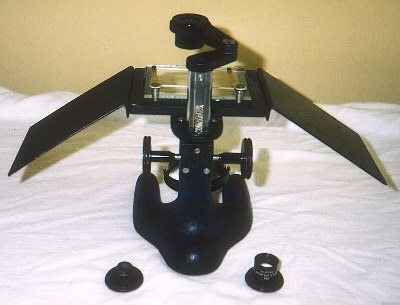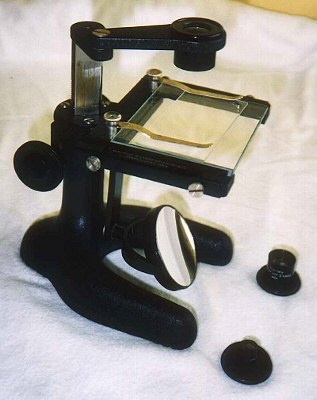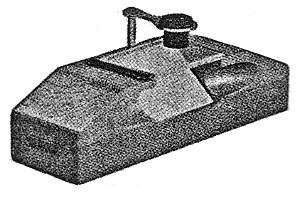
My Favorite Microscope Bausch and Lomb Model W dissecting microscope by John S. Wojtowicz, US |
While I must state at the outset that this is not the only microscope I own, my Bausch & Lomb model W dissecting microscope has become a frequently used favorite. I already owned a B&L stereozoom and bought the Model W at an antique fair last spring because I thought it would be nice to have. Little did I realize how nice it would prove to use.
The instrument was designed for low power observations and fine dissections, hence the removable handrests on the sides. For just plain observing, I find they get in the way, so I often do without them.

My set came with three lenses, 7.5X, 10X, and 20X Triple Aplanats whose resolution and flatness of field appears comparable to my modern B&L Hastings Triplets. While it does not have the binocular vision or viewing angle of the stereozoom, the instrument is light and compact enough to fit into a camera bag, so is quite easily used in the field. Compared to a handheld Hastings, the view is naturally much steadier and the rack and pinion focusing allows finer control, especially with the 20X lens. A more striking advantage lies in the substage mirror. Since the instrument allows the use of both incident and transmitted lighting simultaneously, the views are wonderful. Furthermore, the mirror allows extensive adjustments in lighting. In the field, one can change the background color to that of the blue sky, a white cloud, or even reflect the color of one's shirt. A black background can be instantly obtained by putting the mirror on edge, or slipping a black plate under the stage glass. When observing active creatures such as a small caterpillar inching its way across the stage the quickness and variety of the lighting options greatly increases the detail that can be seen.

So there you have it. A compact, rugged instrument providing a steady, sharp image with extensively adjustable illumination. Where can you buy one? Ah, that's the problem. The design seems to have pretty much died out. I found my instrument pictured in a 1931 Ward's Scientific catalog. Back then it would have cost $42.50 with the three lenses. There was a fourth aplanat, a 15X, available. One could also purchase less expensive Coddington lenses for the stand, and there was also a less expensive stand available without the rack and pinion focusing. The general design appears to be quite old. Microscopes of somewhat similar design were used by both Brown and Darwin. These did have high power lenses, but in that era a single aspherical lens was considered the best way to get high resolution at high magnification. These days, 20X is considered the practical limit for simple magnifiers, and compound designs with ocular and objective lenses in barrels a few inches long are available to provide higher magnifications. I have seen pictures of such in 1880's catalogs, and modern versions are available today that could be easily adapted by adding a collar so it would seat firmly in the lens holding arm on the stand.

A friend whose hobby is botanical illustration found the instrument ideal for her work, and was able to obtain an unbranded Japanese version dating from, we guess, the 1960's. If one were unable to buy one, or just wished to investigate the idea at minimal expense, it would be relatively easy to build a less compact stand out of a block of wood with some sort of sliding post to support a pocket lens, and a substage mirror beneath. In fact, some older dissecting microscopes were made this way. These typically had a mirror permanently set at a 45 degree angle. Since the adjustment of the lighting is so desirable, it would be far better to use a fork mounted circular substage mirror. The concave surface is somewhat useful for the 20X, but for the vast majority of situations the plane surface is preferable. With a little more work one could make a compact field stand similar to Darwin's. Very simply, it was a box just large enough to hold the lenses and parts with holes on one side to hold the mirror support and the focusing post which held the specimen stage and the lens arm, the box serving as the base. If you have some appropriate microscope parts around, try it. I think you will be pleased.
Comments to the author John S. Wojtowicz welcomed.
Editor's note: Do you have a favourite microscope, of whatever vintage or style? Why not share your enthusiasm for it on Micscape and help build up a valuable web resource on microscopes for readers. Contact Editor via link below.
Published in March 1999 Micscape Magazine.
Please report any Web problems
or offer general comments to the Micscape Editor,
via the contact on current Micscape Index.
Micscape is the on-line monthly
magazine of the Microscopy UK web
site at Microscopy-UK